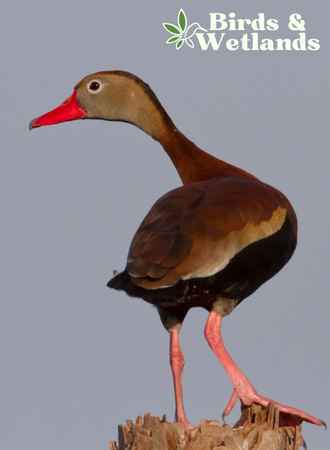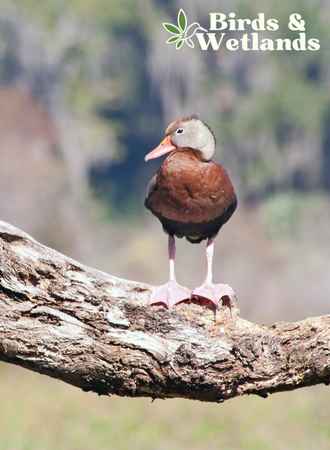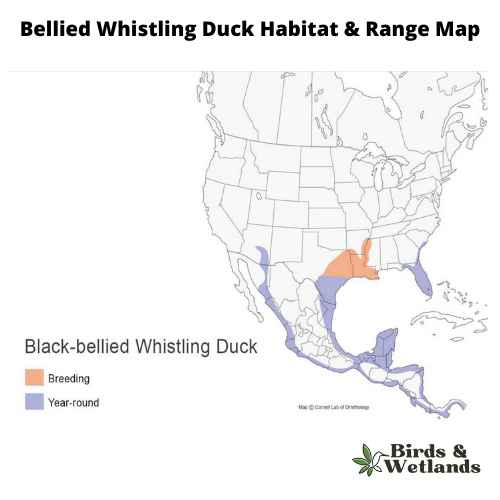Black-bellied whistling ducks are energetic, medium-sized birds found in the southern parts of the United States and various locations in Central and South America.
Black-bellied whistling ducks are also known as Mexican squealers due to their characteristic call, which is a loud, high-pitched whistle.
Their appearance and behavior more resemble geese and swans than ducks. Like these waterfowl, black-bellied whistling ducks form long-term pair bonds but lack any pair-forming behaviors. Due to the lack of sexual dimorphism, it is difficult to distinguish between sexes without close inspection.
Scientific Name: Dendrocygna autumnalis
Height: 17-24 inches
Wingspan: 31.5-34.3 inches
Weight: 1.5-2.7 lbs
Bellied Whistling Duck Description
There are two subspecies of black-bellied whistling ducks:
- D. a. fulgens — Largest of the two. Brown breasts and upper back.
- D. a. autumnalis — Smaller subspecies. Gray breasts and upper back.

Appearance
Black-bellied whistling ducks have tawny-brown to brown-cinnamon upper parts, with black rumps and uppertail coverts. The wings are broad and white, with conspicuous stripes visible in flight. The bird’s underparts are paler, with a tawny-brown lower neck and chest.
This duck has a black belly and flanks, and mottled black and white undertail coverts. Its bill is bright pinkish-red with a yellowish base, while its eyes are dark brown, with a conspicuous white eye ring. Its long legs and webbed feet are also pinkish-red.
Both males and females of the species are similar in appearance.
Juvenile black-bellied whistling ducks have paler and duller plumage than adults, with sooty-brown bellies instead of black. They also have a gray bill and legs. They reach adult plumage at eight months.
Listen to Black-Bellied Whistling Ducks
Bellied Whistling Duck Habitat
Black-bellied whistling ducks inhabit shallow ponds, fresh marshes, flooded rice fields, swampy forests and lagoons in tropical and subtropical regions. Birds prefer shallow water and dense vegetation for nesting.
During the day, they frequently perch on trees or shrubs. Trees or the ground serve as roosts at night for these birds.
These ducks form close bonds with other members of their flock.
Recently, these ducks have adapted well to life in human-altered habitats, settling in city parks and agricultural fields. Despite not being migratory, these ducks travel short distances searching for food and nesting sites.

Bellied Whistling Duck Range
These whistling ducks are widespread in Central and South America. While their exact breeding range is unknown, several flocks have been sighted from northern Argentina to the southern United States. Flocks have been spotted along the west side of the Gulf Coast.
In recent years, there have been reports of this whistling duck breeding as far north as Canada, but it is still being determined if these birds are truly wild or if they are escapees from captivity.

Bellied Whistling Duck Diet
Like other ducks, their diet is predominately herbivorous, consisting mostly of aquatic plants, waste grain, and weeds. They will also feed on small insects, snails, and crustaceans. This species is known to upend in shallow water to reach food items at the bottom.
These ducks typically forage in large flocks. Their diet helps to control the growth of aquatic vegetation and can help to keep wetlands healthy.
Black-Bellied Whistling Ducks Nesting & Mating Habits
These ducks build nests in tree cavities and in nest boxes. Some ducks also build ground nests without any down feather lining, only a shallow cup with woven grasses and other thick vegetation.
These ducks perform egg dumping when females lay eggs in each others’ nests.

Black-Bellied Whistling Ducks Population & Conservation
Despite being classified as “Least Concern” by the IUCN and with populations increasing, these ducks face several threats, including habitat loss and pollution.
Key Points
- Black-bellied whistling ducks are one of the two whistling ducks native to North America, the other being the fulvous whistling duck.
- This duck is known for its long neck, black belly, gray face and upper neck, broad wings, chestnut breast, bright pink bill, short tail and long pink legs.
- Its preferred habitat is a wooded area near the water.

